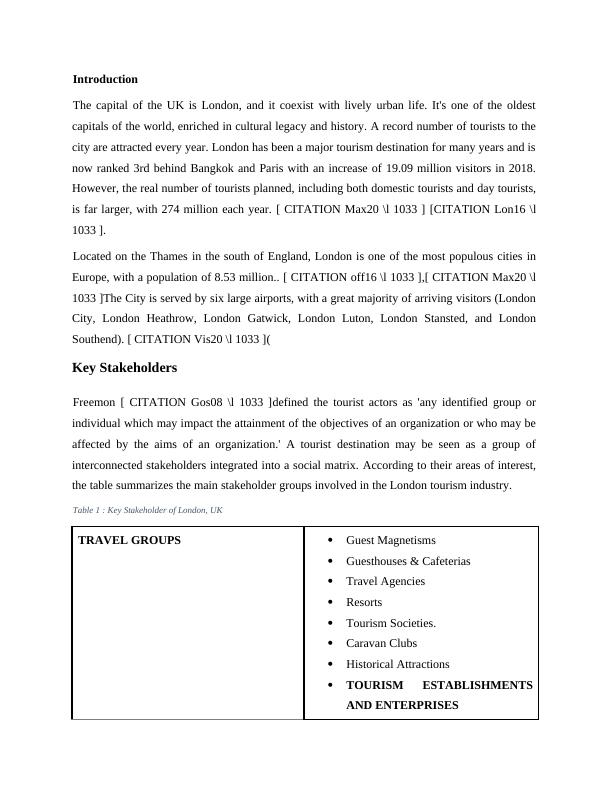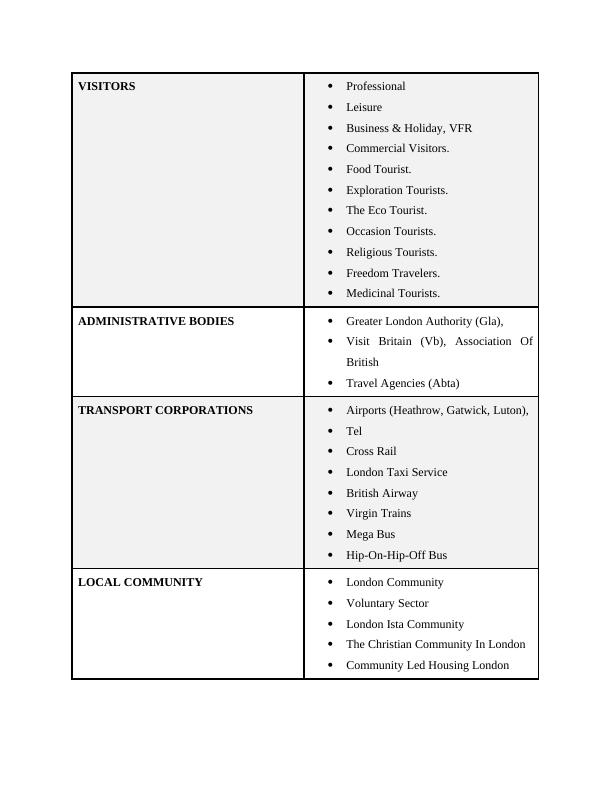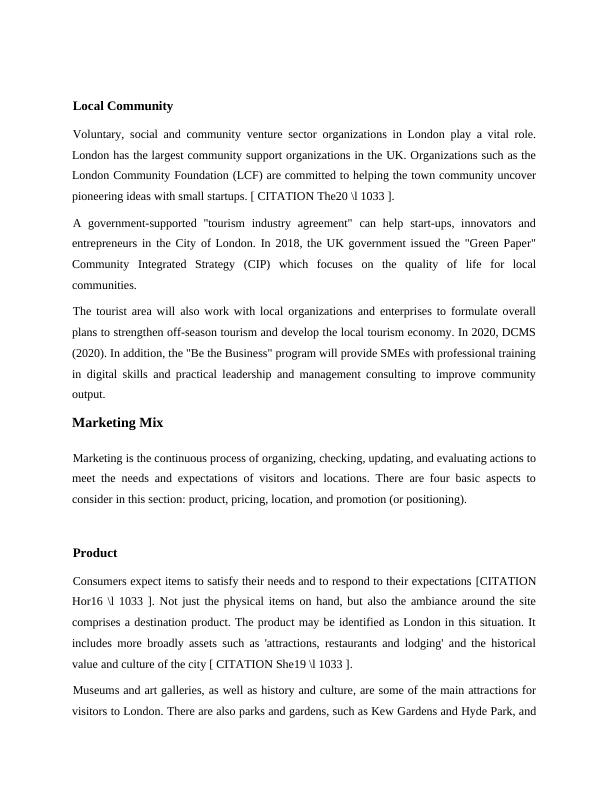London's Destination Management Strategy as a Tourism Destination
21 Pages6060 Words100 Views
Added on 2021-10-01
About This Document
Executive Summary 1 Key Stakeholders 3 Tourism Organizations 5 Government Agencies 5 Local Community 6 Marketing Mix 6 Product 6 Price 7 Place 9 Promotion 9 Destinations Branding 10 Market Segmentation 10 Geographic 10 Demographic 11 Psychographic 11 Behavioral 12 Challenges faced by London as a destination 13 Recommendations 15 Improvement of repetitive visitors’ services 16 Preparations for recovering Covid-19 16 Providing tourists with better accessibility. London is the largest tourism destination for many years and is now ranked 3rd behind Bangkok and Paris with an increase of 19.09
London's Destination Management Strategy as a Tourism Destination
Added on 2021-10-01
ShareRelated Documents
Executive Summary
The purpose of this research is to make recommendations for improving London's destination
management strategy as a tourism destination. Various major tourist initiatives in London were
examined in order to attain the aforementioned goals. First, an overview of London as a tourist
destination is provided. This is followed by an examination of the destination's main
stakeholders as well as its existing marketing strategy based on the 4Ps. (Project, price, location
and promotion) Therefore, the local brand strategy is solved. In addition, this research looks at
the segmentation of the London market to determine the visitor profile and visitor characteristics
of those who visit the city. After that, there is a list of suggestions.
The purpose of this research is to make recommendations for improving London's destination
management strategy as a tourism destination. Various major tourist initiatives in London were
examined in order to attain the aforementioned goals. First, an overview of London as a tourist
destination is provided. This is followed by an examination of the destination's main
stakeholders as well as its existing marketing strategy based on the 4Ps. (Project, price, location
and promotion) Therefore, the local brand strategy is solved. In addition, this research looks at
the segmentation of the London market to determine the visitor profile and visitor characteristics
of those who visit the city. After that, there is a list of suggestions.

Table of Contents
Executive Summary.........................................................................................................................1
Key Stakeholders.............................................................................................................................3
Tourism Organizations................................................................................................................5
Government Entities....................................................................................................................5
Local Community........................................................................................................................6
Marketing Mix.................................................................................................................................6
Product.........................................................................................................................................6
Price.............................................................................................................................................7
Place............................................................................................................................................9
Promotion....................................................................................................................................9
Destination Branding.....................................................................................................................10
Market Segmentation.....................................................................................................................10
Geographic................................................................................................................................10
Demographic.............................................................................................................................11
Psychographic............................................................................................................................11
Behavioral..................................................................................................................................12
Challenges faced by London as a destination................................................................................13
Recommendations.........................................................................................................................15
Improvement of repetitive visitors’ services.............................................................................16
Preparations for recovering Covid-19.......................................................................................16
Providing tourists with better accessibility................................................................................16
References.....................................................................................................................................17
Executive Summary.........................................................................................................................1
Key Stakeholders.............................................................................................................................3
Tourism Organizations................................................................................................................5
Government Entities....................................................................................................................5
Local Community........................................................................................................................6
Marketing Mix.................................................................................................................................6
Product.........................................................................................................................................6
Price.............................................................................................................................................7
Place............................................................................................................................................9
Promotion....................................................................................................................................9
Destination Branding.....................................................................................................................10
Market Segmentation.....................................................................................................................10
Geographic................................................................................................................................10
Demographic.............................................................................................................................11
Psychographic............................................................................................................................11
Behavioral..................................................................................................................................12
Challenges faced by London as a destination................................................................................13
Recommendations.........................................................................................................................15
Improvement of repetitive visitors’ services.............................................................................16
Preparations for recovering Covid-19.......................................................................................16
Providing tourists with better accessibility................................................................................16
References.....................................................................................................................................17

Introduction
The capital of the UK is London, and it coexist with lively urban life. It's one of the oldest
capitals of the world, enriched in cultural legacy and history. A record number of tourists to the
city are attracted every year. London has been a major tourism destination for many years and is
now ranked 3rd behind Bangkok and Paris with an increase of 19.09 million visitors in 2018.
However, the real number of tourists planned, including both domestic tourists and day tourists,
is far larger, with 274 million each year. [ CITATION Max20 \l 1033 ] [CITATION Lon16 \l
1033 ].
Located on the Thames in the south of England, London is one of the most populous cities in
Europe, with a population of 8.53 million.. [ CITATION off16 \l 1033 ],[ CITATION Max20 \l
1033 ]The City is served by six large airports, with a great majority of arriving visitors (London
City, London Heathrow, London Gatwick, London Luton, London Stansted, and London
Southend). [ CITATION Vis20 \l 1033 ](
Key Stakeholders
Freemon [ CITATION Gos08 \l 1033 ]defined the tourist actors as 'any identified group or
individual which may impact the attainment of the objectives of an organization or who may be
affected by the aims of an organization.' A tourist destination may be seen as a group of
interconnected stakeholders integrated into a social matrix. According to their areas of interest,
the table summarizes the main stakeholder groups involved in the London tourism industry.
Table 1 : Key Stakeholder of London, UK
TRAVEL GROUPS Guest Magnetisms
Guesthouses & Cafeterias
Travel Agencies
Resorts
Tourism Societies.
Caravan Clubs
Historical Attractions
TOURISM ESTABLISHMENTS
AND ENTERPRISES
The capital of the UK is London, and it coexist with lively urban life. It's one of the oldest
capitals of the world, enriched in cultural legacy and history. A record number of tourists to the
city are attracted every year. London has been a major tourism destination for many years and is
now ranked 3rd behind Bangkok and Paris with an increase of 19.09 million visitors in 2018.
However, the real number of tourists planned, including both domestic tourists and day tourists,
is far larger, with 274 million each year. [ CITATION Max20 \l 1033 ] [CITATION Lon16 \l
1033 ].
Located on the Thames in the south of England, London is one of the most populous cities in
Europe, with a population of 8.53 million.. [ CITATION off16 \l 1033 ],[ CITATION Max20 \l
1033 ]The City is served by six large airports, with a great majority of arriving visitors (London
City, London Heathrow, London Gatwick, London Luton, London Stansted, and London
Southend). [ CITATION Vis20 \l 1033 ](
Key Stakeholders
Freemon [ CITATION Gos08 \l 1033 ]defined the tourist actors as 'any identified group or
individual which may impact the attainment of the objectives of an organization or who may be
affected by the aims of an organization.' A tourist destination may be seen as a group of
interconnected stakeholders integrated into a social matrix. According to their areas of interest,
the table summarizes the main stakeholder groups involved in the London tourism industry.
Table 1 : Key Stakeholder of London, UK
TRAVEL GROUPS Guest Magnetisms
Guesthouses & Cafeterias
Travel Agencies
Resorts
Tourism Societies.
Caravan Clubs
Historical Attractions
TOURISM ESTABLISHMENTS
AND ENTERPRISES

VISITORS Professional
Leisure
Business & Holiday, VFR
Commercial Visitors.
Food Tourist.
Exploration Tourists.
The Eco Tourist.
Occasion Tourists.
Religious Tourists.
Freedom Travelers.
Medicinal Tourists.
ADMINISTRATIVE BODIES Greater London Authority (Gla),
Visit Britain (Vb), Association Of
British
Travel Agencies (Abta)
TRANSPORT CORPORATIONS Airports (Heathrow, Gatwick, Luton),
Tel
Cross Rail
London Taxi Service
British Airway
Virgin Trains
Mega Bus
Hip-On-Hip-Off Bus
LOCAL COMMUNITY London Community
Voluntary Sector
London Ista Community
The Christian Community In London
Community Led Housing London
Leisure
Business & Holiday, VFR
Commercial Visitors.
Food Tourist.
Exploration Tourists.
The Eco Tourist.
Occasion Tourists.
Religious Tourists.
Freedom Travelers.
Medicinal Tourists.
ADMINISTRATIVE BODIES Greater London Authority (Gla),
Visit Britain (Vb), Association Of
British
Travel Agencies (Abta)
TRANSPORT CORPORATIONS Airports (Heathrow, Gatwick, Luton),
Tel
Cross Rail
London Taxi Service
British Airway
Virgin Trains
Mega Bus
Hip-On-Hip-Off Bus
LOCAL COMMUNITY London Community
Voluntary Sector
London Ista Community
The Christian Community In London
Community Led Housing London

Tourism Organizations
Tourism organizations, for example the public and private sector, may be separated into
different sectors depending on separate interests and priorities, further broken down into sub-
sections such as government bodies, accommodation or tourist attractions. [ CITATION
Mor13 \l 1033 ]- defines officially formally formalized and codified formalized formalized The
city generates the most turism revenues in 2018, with 54 percent of its entire incoming tourist
numbers accounted for inside London in 2018 [CITATION Con20 \l 1033 ]. Many travel
companies in London provide everything for high-end customers, from tourist attractions (such
as the London Eye and Tower of London) to world-class accommodation and dining options
such as "The Savoy" and "The Sofitel London St.". James. ' [ CITATION Vis201 \l 1033 ] In
addition, six airports where the bulk of incoming tourists enter the city are located. In addition
to the 600 DMOs throughout London, there are more than 2300 travel agencies in the UK.
[ CITATION АВТ20 \l 1033 ].
Government Entities
A government system can identify several stakeholders with various goals and duties.
[ CITATION Tim08 \l 1033 ]Many government agencies work together to promote London
globally and regionally. The Digital, Cultural, Media and Sports Department (DCMS) is one of
the largest government agencies in the world that supports development, improves people's lives
and promotes Britain. DCMS' main purpose is to maintain and promote the British history,
while enabling communities and industries to develop by boosting the image of Britain and
displaying the distinctiveness of the country [ CITATION DCM20 \l 1033 ]
Visit Britain is the national tourism organization in charge of the development of the UK
visitors' economy through global marketing. VB also works along with tour operators, airlines,
international brands and the UK's statutory tourism agencies. European Office in Brussels in
London monitors and impacts EU policies and identifies opportunities to get EU subsidies.
London & Partners is the city's official regional marketing, investment and trading agency
abroad. It guarantees that London's interests are taken into account when formulating EU plans
and policies. Students will be able to study, communicate and grow in London after the UK
leaves the European Union.. [ CITATION Lon20 \l 1033 ]
Tourism organizations, for example the public and private sector, may be separated into
different sectors depending on separate interests and priorities, further broken down into sub-
sections such as government bodies, accommodation or tourist attractions. [ CITATION
Mor13 \l 1033 ]- defines officially formally formalized and codified formalized formalized The
city generates the most turism revenues in 2018, with 54 percent of its entire incoming tourist
numbers accounted for inside London in 2018 [CITATION Con20 \l 1033 ]. Many travel
companies in London provide everything for high-end customers, from tourist attractions (such
as the London Eye and Tower of London) to world-class accommodation and dining options
such as "The Savoy" and "The Sofitel London St.". James. ' [ CITATION Vis201 \l 1033 ] In
addition, six airports where the bulk of incoming tourists enter the city are located. In addition
to the 600 DMOs throughout London, there are more than 2300 travel agencies in the UK.
[ CITATION АВТ20 \l 1033 ].
Government Entities
A government system can identify several stakeholders with various goals and duties.
[ CITATION Tim08 \l 1033 ]Many government agencies work together to promote London
globally and regionally. The Digital, Cultural, Media and Sports Department (DCMS) is one of
the largest government agencies in the world that supports development, improves people's lives
and promotes Britain. DCMS' main purpose is to maintain and promote the British history,
while enabling communities and industries to develop by boosting the image of Britain and
displaying the distinctiveness of the country [ CITATION DCM20 \l 1033 ]
Visit Britain is the national tourism organization in charge of the development of the UK
visitors' economy through global marketing. VB also works along with tour operators, airlines,
international brands and the UK's statutory tourism agencies. European Office in Brussels in
London monitors and impacts EU policies and identifies opportunities to get EU subsidies.
London & Partners is the city's official regional marketing, investment and trading agency
abroad. It guarantees that London's interests are taken into account when formulating EU plans
and policies. Students will be able to study, communicate and grow in London after the UK
leaves the European Union.. [ CITATION Lon20 \l 1033 ]

Local Community
Voluntary, social and community venture sector organizations in London play a vital role.
London has the largest community support organizations in the UK. Organizations such as the
London Community Foundation (LCF) are committed to helping the town community uncover
pioneering ideas with small startups. [ CITATION The20 \l 1033 ].
A government-supported "tourism industry agreement" can help start-ups, innovators and
entrepreneurs in the City of London. In 2018, the UK government issued the "Green Paper"
Community Integrated Strategy (CIP) which focuses on the quality of life for local
communities.
The tourist area will also work with local organizations and enterprises to formulate overall
plans to strengthen off-season tourism and develop the local tourism economy. In 2020, DCMS
(2020). In addition, the "Be the Business" program will provide SMEs with professional training
in digital skills and practical leadership and management consulting to improve community
output.
Marketing Mix
Marketing is the continuous process of organizing, checking, updating, and evaluating actions to
meet the needs and expectations of visitors and locations. There are four basic aspects to
consider in this section: product, pricing, location, and promotion (or positioning).
Product
Consumers expect items to satisfy their needs and to respond to their expectations [CITATION
Hor16 \l 1033 ]. Not just the physical items on hand, but also the ambiance around the site
comprises a destination product. The product may be identified as London in this situation. It
includes more broadly assets such as 'attractions, restaurants and lodging' and the historical
value and culture of the city [ CITATION She19 \l 1033 ].
Museums and art galleries, as well as history and culture, are some of the main attractions for
visitors to London. There are also parks and gardens, such as Kew Gardens and Hyde Park, and
Voluntary, social and community venture sector organizations in London play a vital role.
London has the largest community support organizations in the UK. Organizations such as the
London Community Foundation (LCF) are committed to helping the town community uncover
pioneering ideas with small startups. [ CITATION The20 \l 1033 ].
A government-supported "tourism industry agreement" can help start-ups, innovators and
entrepreneurs in the City of London. In 2018, the UK government issued the "Green Paper"
Community Integrated Strategy (CIP) which focuses on the quality of life for local
communities.
The tourist area will also work with local organizations and enterprises to formulate overall
plans to strengthen off-season tourism and develop the local tourism economy. In 2020, DCMS
(2020). In addition, the "Be the Business" program will provide SMEs with professional training
in digital skills and practical leadership and management consulting to improve community
output.
Marketing Mix
Marketing is the continuous process of organizing, checking, updating, and evaluating actions to
meet the needs and expectations of visitors and locations. There are four basic aspects to
consider in this section: product, pricing, location, and promotion (or positioning).
Product
Consumers expect items to satisfy their needs and to respond to their expectations [CITATION
Hor16 \l 1033 ]. Not just the physical items on hand, but also the ambiance around the site
comprises a destination product. The product may be identified as London in this situation. It
includes more broadly assets such as 'attractions, restaurants and lodging' and the historical
value and culture of the city [ CITATION She19 \l 1033 ].
Museums and art galleries, as well as history and culture, are some of the main attractions for
visitors to London. There are also parks and gardens, such as Kew Gardens and Hyde Park, and

End of preview
Want to access all the pages? Upload your documents or become a member.
Related Documents
Travel Geography: Key Airports and Attractions in Londonlg...
|8
|2499
|95
Tourism and Destination Management - Assignmentlg...
|20
|6629
|140
Road map to Destination Successlg...
|14
|3224
|1
Research Report on Tourist Destination - TUI Grouplg...
|18
|6004
|387
Study on Tourist Destination- TUI grouplg...
|16
|5076
|51
Tourist Destinations - TUI Group Reportlg...
|18
|4677
|204
